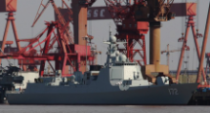
China’s growing naval power has become a frequent topic of discussion in recent years as Beijing has increasingly asserted itself in the maritime realm. There is significant coverage of procurement related to China’s aircraft carriers, submarines and anti-ship ballistic missiles. In contrast, relatively little attention is paid to the rapid modernization of the People’s Liberation Army Navy (PLAN) surface fleet. This relative dearth of coverage is unfortunate as it results in the overlooking of a key facet of China’s remarkable naval modernization.
The PLAN entered the twenty-first century with under a dozen warships which could be considered ‘modern’ by any standard. At the time, the majority of the PLAN’s surface fleet consisted of dozens of destroyers and frigates, based mainly on 1960s-1970s era Soviet technology. There was also a smattering of 1980s-vintage British, Italian, and French technologies incorporated in certain variants and upgrades.
At the start of the 21st century the PLAN was in the early stages of what has turned into an extensive modernization effort. This effort began with the emergence in the 1990s of the two indigenous 052/Luhu-class and the sole 051B/Luhai-class destroyers. These ships constituted China’s first foray into building high-end warships. In addition, China procured from Russia two Russian Sovremenny-class destroyers. At the same time, the improved Type 053H3 Jiangwei II-class frigates program, a new tranche of an existing design, produced eight somewhat modern frigates. These classes formed the small core of an emerging modern navy.
Between 2000 and 2004, the only new surface naval combatant added to the PLAN were two of the eight Type 053H3 class frigates already mentioned. Beginning in 2004, the PLAN’s surface combatant modernization began speeding up. The PLAN has commissioned no fewer than 54 new surface naval combatants between 2004 and now. This number only includes destroyers, frigates, and corvettes, and does not factor in the acquisition of substantial numbers of submarines, patrol vessels, logistical support vessels, coast guard vessels operated by other government agencies, or amphibious transport vessels. It also does not include ships currently undergoing sea trials or in the late stages of construction, of which there are approximately fifteen, the seven plus ships at less advanced stages of construction, or the dozens of vessels that planned or are on order books. The bulk of these ships have been general purpose multi-role frigates and, more recently, patrol corvettes. Simultaneously, the PLAN has also been building large numbers of air defence destroyers. The table below presents the number of surface combatants commissioned during this period.
| Year | # of Primary Surface Combatants Commissioned |
| 2004 | 2 |
| 2005 | 6 |
| 2006 | 3 |
| 2007 | 1 |
| 2008 | 4 |
| 2009 | 0 |
| 2010 | 3 |
| 2011 | 2 |
| 2012 | 4 |
| 2013 | 13 |
| 2014 | 12 |
| 2015* (As of 02/05/2015) | 4 |
| Rest of 2015* (Estimate) |
The bulk of the PLAN’s modern surface combatants are composed of four classes: two related destroyer classes, one frigate class, and one corvette class. A sizable number of the PLANs modern destroyers are the six 052C Luyang II-class, all of which are now in service. Notably, this six-strong class has an average age of just over four years. Two were commissioned in 2005 and the rest since 2013. These destroyers are the the first advanced and indigenously constructed vessels of their kind and constitute the core of China’s destroyer fleet. The PLAN Navy has evolved the 052C into the more advanced 052D air warfare destroyer.
The 052D deserves particular attention as it demonstrates China’s intent to produce large numbers of high end vessels instead of emphazing less expensive multi-role frigates and corvettes. The first 052D was completed in 2012. One 052D is in service, three are undergoing sea trials, and two are in the late stages of production. A further four vessels are under varying stages of construction and an additional two are reported to be on order. Since 2010, China has been constructing 14 new air-warfare destroyers.
The ‘work-horse’ of the PLAN is the Type 054A/Jiangkai II-class frigate. Developed from the indigenous Type 054 frigate, of which two were built in 2003, the PLAN has built and commissioned twenty-two 054As since 2006. These vessels are less advanced and capable than the Type 052C/D destroyers, but are also significantly cheaper. They are also ideally suited for general purpose patrol and escort tasks. Since 2010, the PLAN has commissioned 14 054As, with four more in the late stages of construction. An additional two vessels, hulls 23 and 24, are under construction and are assumed to be the last vessels of the class before production shifts to a new frigate design.
At the same time, the 054As ‘work-horse’ role is being reduced by the introduction of the new Type 056/Jiangdao-class corvette. The 056 is less capable and more affordable than the Type 054As, but is suited to patrolling the South and East China Seas, freeing up the 054As for deployments further from China, such as the anti-piracy patrol off Somalia. As such, these small and modest vessels are extremely important to the PLAN’s future. With the Type 056, the PLAN has the distinction of being the only country currently mass-producing (i.e. mass parallel production, not serial production) a large naval vessel. The number of Type 056 corvettes to be built is unclear, but open source estimates suggest the total figure may be well over 30 vessels in the short term, with the total likely of over 50 vessels.
While such numbers are considerable, even more impressive is that fact that despite the first Type 056 being commissioned only in 2013, the PLAN has already commissioned 19 Type 056 corvettes. In addition, six 056s are at a later stage with an uncertain but large number on order or beginning production. By the end of 2015 the PLAN is likely to have commissioned twenty-four Type 056 corvettes. This staggering number will have been commissioned in just two years with average commission rate per year at 12 ships. No country in the world comes close to matching such a production schedule for any vessel larger than a small patrol boat.
In addition to these vessel classes, work is underway on at least two new classes. The first is the Type 055 destroyer/cruiser, which is a newly designed large destroyer substantially larger than the already large Type 052C/D destroyers. The Type 055s will likely carry advanced air defence systems and large numbers of missiles in a vertical launch system. They will likely be the escort vessels for Chinese aircraft carriers. In an attempt to improve its anti-submarine warfare capabilities, China is also believed to be beginning work on the new Type 054B class frigate. An evolution of the Type 054A, the 054B will likely take the place of the Type 054A at busy Chinese shipyards. In addition, the Type 056 corvette is being developed into a new anti-submarine variant. Two such vessels are already in service with a further five at a late stage of production (they are included in the Type 056 production figures).
| Warships Commissioned by China by Class and Date (Excluding ships on order and those not at late stages of production) | |||||||||||||||
| Class | Type | 2004 | 2005 | 2006 | 2007 | 2008 | 2009 | 2010 | 2011 | 2012 | 2013 | 2014 | 2015 | 2015* | Total |
| 052D | Destroyer | 1 | 2* | 3 | |||||||||||
| 052C | Destroyer | 2 | 2 | 1 | 1 | 6 | |||||||||
| 052B | Destroyer | 2 | 2 | ||||||||||||
| 051C | Destroyer | 1 | 1 | ||||||||||||
| Sovremenny | Destroyer | 2 | 2 | ||||||||||||
| 054A | Frigate | 4 | 3 | 2 | 4 | 3 | 2 | 2* | 20 | ||||||
| 054 | Frigate | 2 | 2 | ||||||||||||
| 053H3 | Frigate | 2 | 2 | ||||||||||||
| 056 | Corvette | 8 | 10 | 1 | 5* | 24 | |||||||||
| Totals | 2 | 6 | 3 | 0 | 4 | 0 | 3 | 2 | 4 | 13 | 12 | 4 | 9 | 62 | |
The Chinese navy has made remarkable progress in terms of submarines, aircraft carriers, and anti-ship ballistic missiles in the last 15 years At the same time, the PLAN has undergone an equally rapid and substantial modernization of its surface naval vessels. Indeed, few countries come anywhere close to the scale and substance of China’s surface combatant modernization. Overlooking these developments would lead to a serious underestimation of China’s naval trajectory.




